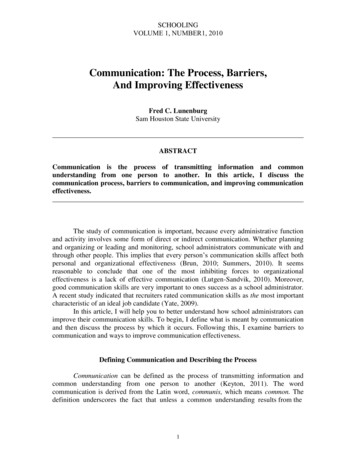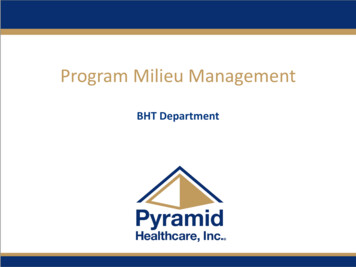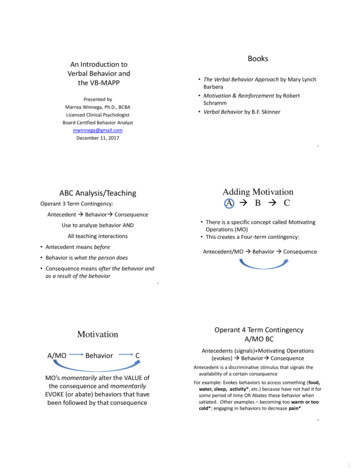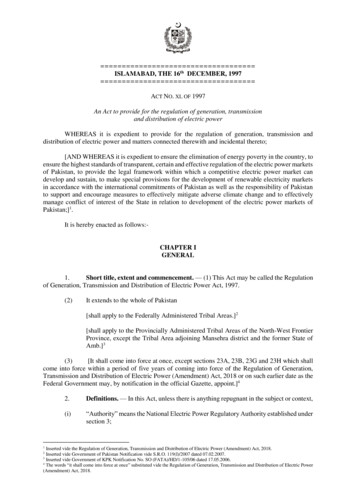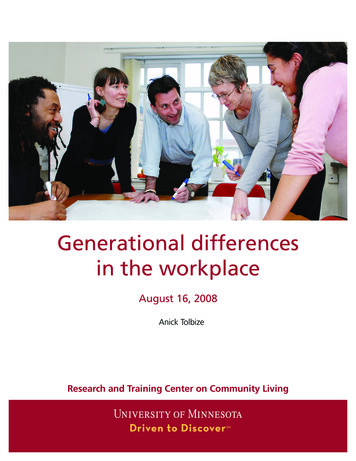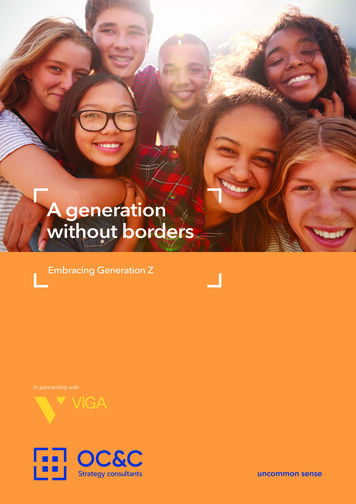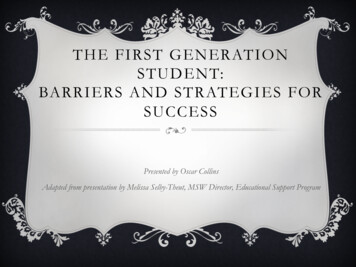
Transcription
THE FIRST GENERATIONSTUDENT:BARRIERS AND STRATEGIES FORSUCCESSPresented by Oscar CollinsAdapted from presentation by Melissa Selby-Theut, MSW Director, Educational Support Program
STATISTICALOVERVIEWv First-generation students: Comprise 34% of the population at colleges anduniversities nationwide. (28-30% @ Umass annually) Are more likely to be racial/ethnic minorities, be lowincome, and have dependent children. Enroll in and graduate from college at significantly lowerrates that their second- and third-generation peers.
v 85% of second- and third-generation students attempt collegeafter high school 47% of first-generation students attempt college after high schoolv 68% of second- and third-generation students graduate with abachelor’s degree within 8 years 26% of first-generation students graduate with a bachelor’s degree within8 years
Michelle Obama on Imposter Syndrome!First-generation students graduate at a significantly lower rate,even when demographics, motivation, academic preparation,academic progress, grade point average, and income areaccounted for!
AC A D E M I C BA R R I E R SAND UNIVERSITY CHALLENGESBarrierChallengev Report lower educational aspirationsv Create an environment that affirmsv More likely to enter collegestudents’ strengths and encourages theiracademically underpreparededucational pursuitsv Reading comprehension and criticalv Provide opportunities forthinking do not improve at as high a ratesupplementary instruction, remedialv Earn lower GPAs and take fewerinstruction, and/or learning skillacademic hoursdevelopmentv Avoid majors and courses in math,v Demonstrate the value of liberalscience, and humanitieseducation
C U LT U R A L BA R R I E R SAND UNIVERSITY CHALLENGESBarrierChallengev Less likely to identify college as necessary tov Demonstrate the long-term benefits of aachieving goalscollege educationv Parents lack “college knowledge” related tov Integrate with family to create “buy-in”navigating the college environmentwhen possible and/or appropriate; encouragev Only 50% identify their parents asautonomy as necessarysupportive of their decision to attend collegev Assist students in recognizing andv “[Live] simultaneously in two vastlyaccepting their dual rolesdifferent worlds while being fully accepted inv Provide culturally-sensitive services thatneither”address the specific needs of first-generationstudents
S O C I A L BA R R I E R SAND UNIVERSITY CHALLENGESBarrierChallengev More likely to live off-campusv Provide cost-effective housing options and/v Less likely to participate in on-campusor ways to integrate with Housing programsorganizations/eventsand initiativesv Identify their closest friends as full-timev Target first-generation students whenemployees rather than college studentsadvertising organizations and eventsv Report higher rates of isolation andv Foster a safe and inclusive campusdiscriminationcommunityv Perceive faculty as “distant” or unconcernedv Create opportunities for first-generationwith them as individualsstudents to form relationships with faculty
F I N A N C I A L BA R R I E R SAND UNIVERSITY CHALLENGESBarrierv Uninformed about financial aid – forms,processes, etc.v More likely to have additional financialobligationsChallengev Supply materials about financial aidand the financial aid process that areeasy to access and easy to understandv Have fewer resources to pay for collegev Assist students in minimizing out-v Nature of and time allotted to work differof-pocket costsfrom that of second-generation studentsv More likely to meet employment obligationsthan academic obligationsv Provide ample opportunities foron-campus employment
WHAT WORKSv Outside of the classroom Ensuring that students are socially integratedProviding intensive, holistic support servicesForming authentic relationships between students and staffRecognizing and celebrating diversityv Within the classroom Ensuring that students form relationships with faculty and feelappreciated as individuals Recognizing the unique circumstances of first-generation students andallowing flexibility as appropriate Focusing on improving reading comprehension, critical thinking, andmathematical abilities
RESOURCESv CMASS Academic Support/Coaching Intentional Guided Support Resource Referral Connecting Identity to Academicsv College Academic Advising Centers – Directors of Student Success& Diversityv Advisors/ Peer Advisors/ Mentors/ RA’sv CCPHv Financial Aid Office
REFERENCESv Billson, J., & Brooks, T. (1981). In Search of the Silken Purse: Factors in Attrition Among First-GenerationStudents. Presented to the Annual Meeting of the Association of American Colleges. Denver, CO.v Engle, J, Bermeo, A., & O’Brien, C. (2006). Straight from the Source: What Works for First-GenerationCollege Students. Pell Institute for the Study of Opportunity in Higher Education. Washington, DC.v Murphy, C., & Hicks, T. (2006). Academic Characteristics Among First-Generation and Non-FirstGeneration College Students. College Quarterly, vol. 9.v Terenzini, P., Springer, L., Yaeger, P., Pascarella, E., & Nora, A. (1995). First-Generation CollegeStudents: Characteristics, Experiences, and Cognitive Development. Association for Institutional Research.Boston, MA.v First-Generation Students in Postsecondary Education: A Look at Their College Transcripts. (2005). NationalCenter for Education Statistics Descriptive Analysis Report.
Straight from the Source: What Works for First-Generation College Students. Pell Institute for the Study of Opportunity in Higher Education. Washington, DC. ! Murphy, C., & Hicks, T. (2006). Academic Characteristics Among First-Generation and Non-First-Generation College Students. College Quarterly, vol. 9.


